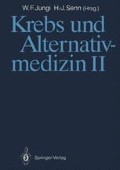Zusammenfassung
Auf Grund ihrer starken photosynthetischen Fähigkeit ist die Mistel eine proteinreiche Pflanze [1]. Durch Gel-Elektrophorese konnten mehr als 500 verschiedene Proteine bestimmt werden [19]. Unter diesen zahlreichen Proteinen sind einige charakteristisch für diese Pflanze [17]. Es sind die Lektine [4, 5, 6, 12, 14, 21], die Viscotoxine [18] und die Vesterschen Proteine [20, 22, 23].
Access this chapter
Tax calculation will be finalised at checkout
Purchases are for personal use only
Preview
Unable to display preview. Download preview PDF.
Literatur
Baudino S, Sallé G (1986) Les substances actives du gui. Propriétés pharmacoliques et applications thérapeutiques. Annales des Sciences Naturelles, Botanique 8:45–72
Endo Y, Tsurugi K, Franz H (1988) The site of action of the A-chain of mistletoe lectin I on eukaryotic ribosomes — The RNA N-glycosidase activity of the protein. FEBS Letters 231:378–380
Franz H, Ziska P, Kindt A (1981) Isolaton and properties of three lectins from mistletoe (Viscum album L.) Biochem J 195:481–484
Franz H (1985) Inhaltsstoffe der Mistel (Viscum album L.) als potentielle Arzneimittel. Pharmazie 40:97–104
Franz H (1986) Mistletoe lectins and their A and B chains. Oncology 43, suppl 1:23–24
Franz H (1989) Viscaceae lectins. In: Franz H (ed) Advances in lectin research Vol 22:28–59. VEB Verlag Volk und Gesundheit, Berlin
Gabius HJ, Rüdiger H, Uhlenbruck G (1988) Spektrum 11:50–60
Gabius HJ (1989) Potential participation of tumor lectins in cancer diagnosis, therapy and biology. In: Franz H (ed) Advances in lectin research Vol 2:87–107. VEB Verlag Volk und Medizin, Berlin
Holstog R, Sandvig K, Olsnes S (1988) Characterization of a toxic lectin in Iscador, a mistletoe preparation with alleged cancerostatic properties. Oncology 45:172–172
Jordan E, Wagner H (1986) Structure and properties of polysaccharides from Viscum album (L.). Oncology 43, suppl 1:8–15
Khwaja TA, Dias CB, Pentecost S (1986) Recent studies of the anticancer activities of mistletoe (Viscum album) and its alkaloids. Oncology 43, suppl 1:42–50
Luther P, Becker H (1987) Die Mistel — Botanik, Lektine, medizinische Anwendung. Verlag Volk und Gesundheit, Berlin
Mechelke F, Hülsen H (1989) Wirksamkeit eines Mistelpräparates auf Zellkulturen Zytostatika-resistenter menschlicher Leukämie-Zellen. Therapeutikon 1:28–30
Olsnes S, Stirpe F, Sandvig K et al (1982) Isolation and characterization of viscumin, a toxic lectin from Viscum album L. (mistletoe). J Biol Chem 257:13263–13270
Ribéreau-Gayon G, Jung ML, Baudino S et al (1986) Effects of mistletoe (Viscum album L.) extracts on cultured tumor cells. Experientia 42:594–599
Ribéreau-Gayon G, Jung ML, Di Scala D et al (1986) Comparison of the effects of fermented and unfermented mistletoe preparations on cultured tumor cells. Oncology 43 suppl 1:35–41
Ribéreau-Gayon G, Jung ML, Beck JP (1989) Die Proteine, Alkaloide und Polysaccharide der Mistel (Viscum album L.) Therapeutikon 1:22–26
Samuelsson G (1974) Mistletoe toxins. Syst Zool 22:566–569
Schink M, Mechelke F (1989) Sex-correlated differences in the protein pattern of Viscum album L. revealed by two-dimensional gel electrophoresis. Naturwissenschaften 76:29–30
Snajberk G (1980) Die kanzerostatischen Wirkungen spezieller Viscum-Proteine — Signifikanz und Wirkungsverluste. Dissertation, München
Stirpe F, Sandvig K, Olsnes S et al (1982) Action of viscumin, a toxic lectin from mistletoe, on cells in culture. J Biol Chem 257:13271–13277
Vester F, Bohne L, El-Fouly EL (1968) Zur Kenntnis der Inhaltsstoffe von Viscum album, IV. Hoppe-Seylers Z Physiol Chem 349:495–511
Vester F (1977) Über die kanzerostatischen und immunogenen Eigenschaften von Mistelproteinen. Krebsgeschehen 5:106–114
Author information
Authors and Affiliations
Rights and permissions
Copyright information
© 1990 Springer-Verlag Berlin Heidelberg
About this paper
Cite this paper
Ribéreau-Gayon, G., Jung, ML., Baudino, S., Beck, JP. (1990). Die Proteine der Mistel (Viscum album L.). In: Krebs und Alternativmedizin II. Springer, Berlin, Heidelberg. https://doi.org/10.1007/978-3-642-74263-7_6
Download citation
DOI: https://doi.org/10.1007/978-3-642-74263-7_6
Publisher Name: Springer, Berlin, Heidelberg
Print ISBN: 978-3-540-50516-7
Online ISBN: 978-3-642-74263-7
eBook Packages: Springer Book Archive

